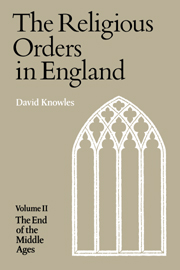Book contents
- Frontmatter
- Contents
- Preface
- List of Abbreviations
- Part One The Historical Framework
- Chap. I The opening of the period
- Chap. II Monks and canons at the university, 130c–1450
- Chap. III Patrons and architects: Ely and Gloucester
- Chap. IV Portraits of monks
- Chap. V Monks and friars in controversy
- Chap. VI Trends in speculation: Ockhamism, justification and grace
- Chap. VII Criticism of the religious in the fourteenth century
- Chap. VIII The spiritual life of the fourteenth century
- Chap. IX Developments within the orders: I
- Chap. X Developments within the orders: II
- Chap. XI The fortunes of the Cluniac houses and the alien priories
- Chap. XII The loosening of discipline
- Chap. XIII King Henry V
- Chap. XIV More portraits of monks
- Chap. XV The second century of visitation, 1350–1450
- Chap. XVI The spiritual life of the fifteenth century
- Part Two The Institutional Background
- Appendix I Chaucer's monk
- Appendix II Henry V and the Westminster recluse
- Appendix III Regulars as bishops
- Bibliography
- Index
Chap. VII - Criticism of the religious in the fourteenth century
Published online by Cambridge University Press: 28 January 2010
- Frontmatter
- Contents
- Preface
- List of Abbreviations
- Part One The Historical Framework
- Chap. I The opening of the period
- Chap. II Monks and canons at the university, 130c–1450
- Chap. III Patrons and architects: Ely and Gloucester
- Chap. IV Portraits of monks
- Chap. V Monks and friars in controversy
- Chap. VI Trends in speculation: Ockhamism, justification and grace
- Chap. VII Criticism of the religious in the fourteenth century
- Chap. VIII The spiritual life of the fourteenth century
- Chap. IX Developments within the orders: I
- Chap. X Developments within the orders: II
- Chap. XI The fortunes of the Cluniac houses and the alien priories
- Chap. XII The loosening of discipline
- Chap. XIII King Henry V
- Chap. XIV More portraits of monks
- Chap. XV The second century of visitation, 1350–1450
- Chap. XVI The spiritual life of the fifteenth century
- Part Two The Institutional Background
- Appendix I Chaucer's monk
- Appendix II Henry V and the Westminster recluse
- Appendix III Regulars as bishops
- Bibliography
- Index
Summary
FITZRALPH AND WYCLIF
During the latter half of the fourteenth century the religious orders, and in particular the friars, were subjected to attacks both public and literary, to which an earlier parallel can only be found in the simultaneous assaults by a group of bishops and by the court circle of writers upon the monks in the last years of Henry II. In the previous onslaught, a number of prelates had sought to eject the monks from their cathedrals or to render them innocuous by the foundation of colleges of secular canons, while at the same time Gerald of Wales and Walter Map were accusing the whole monastic body of luxurious and immoral lives, and of avaricious and dishonest behaviour. Both these attacks had died away with the reign of John: the relations between monks and bishops had been firmly determined by Innocent III, while the extinction of literary humanism and the court culture had put an end to literary polemics. Henceforward for almost a century and a half criticism of the religious in this country had been personal and private only, save for faint echoes at Oxford of the quarrels between the secular masters of Paris and the mendicants. Of literary criticism during this period scarcely anything of weight has survived; the thirteenth century, as is well known, is a barren one in the annals of national literature when compared to the age of Latin culture which preceded it, and the epoch of English renaissance that followed.
- Type
- Chapter
- Information
- Religious Orders Vol 2 , pp. 90 - 114Publisher: Cambridge University PressPrint publication year: 1979

